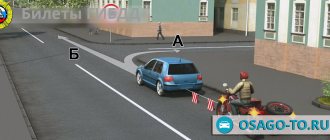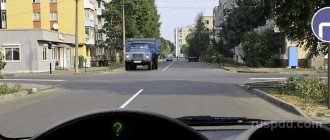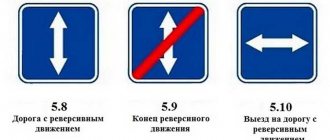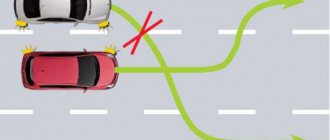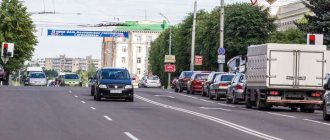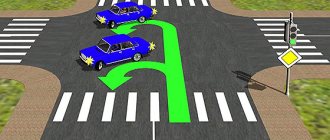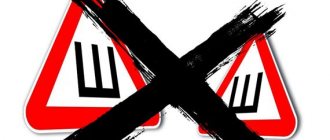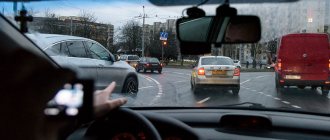Like a pedestrian, a cyclist is part of the road traffic. Everyone who uses a two-wheeled vehicle to move around the city must know the rules and road signs so as not to create emergency situations on the road. According to the traffic rules of Ukraine, a bicycle must be:
- equipped with reflective details. White are installed in front, yellow on the sides and red in the back.
- flashlight. When driving at night or in cloudy weather, a cyclist must turn on a flashlight (headlight). It ensures the cyclist's visibility on the road.
It is recommended to choose a flashlight with a red flashing function. This device produces brighter and more visible light.
Before leaving, be sure to check the serviceability of the bike’s brakes. If a mechanical failure is suspected, the driver should not use two-wheelers for travel, as this may cause an accident.
Cyclists are required to wear reflective clothing when riding on the road. At the same time, it should not hinder his movements while driving a bicycle. It is recommended not to choose clothes that are too loose or long, as they may get tangled in the spokes, pedals or chain. It is best to choose bright colors for clothing to be visible to surrounding drivers on the road. In specialized stores you can purchase a bright yellow vest, which is equipped with reflective stripes.
To protect yourself, you must wear a helmet while riding a bicycle. It will protect your head, the most important part of the body, in case of a fall. Injuring the head during a fall can cause brain damage! A helmet also protects the cyclist from sunstroke or rain.
To protect your hands, wear special cycling gloves. They will help reduce friction, prevent cracks and calluses from appearing on your hands, and protect you in case of a fall. It is also better to choose this accessory with reflective inserts in a bright shade. When cycling fast, dust and sand from the road can often get into your eyes. Wear cycling glasses that will cover your vision.
Basic rules of the road for cyclists
A cyclist on the road is a full participant in the road traffic. He must know the road signs for cyclists and their meaning. Any actions performed by cyclists on the road must be understandable to other road users. Also, they should not be done unexpectedly.
Requirements for a cyclist:
- Only those who have reached the age of 14 have the right to travel on the road.
- The vehicle must be in good working order and equipped with special reflective signs.
- A cyclist has the right to move only in a special lane for this type of transport. If it is missing, then in the far right lane of the roadway. It is also allowed to use the side of the road for movement.
The shoulder is considered to be a section of the road marked by a contour or continuous line of road markings, which is adjacent to the outer edge of the roadway. It is not intended for the movement of vehicles, except in certain cases provided for by traffic regulations. The shoulder can be used to stop vehicles, pedestrians, mopeds and bicycles if there is no sidewalk nearby.
- Leaving the far right lane is only allowed when passing pedestrians, potholes or parked cars.
- If a bicycle road intersects with a car road other than at an intersection, the cyclist must give way to other vehicles moving on the road.
- If a column of cyclists moves along the road, it should be divided into groups of up to 10 people. A distance of 80-100 meters should be maintained between each group. In a group, cyclists are required to ride one after another so as not to create difficulties for other road users.
- While driving on the roadway, a cyclist is required to give special warning signals before making a turn, stopping, making U-turns, etc. They look like this:
- Turning or changing lanes to the right—extend your right arm.
- Turning or changing lanes to the left—left arm extended.
- Stop - hand raised up.
It is also recommended to use a turn signal before passing vehicles parked on the edge of the road. The signal must be given in advance so that road users have time to recognize it and react. In a group of cyclists, the leader gives the signs first. The rest of the group must repeat the maneuver.
- A cyclist has the right to carry luggage that does not interfere with the passage of other vehicles and pedestrians.
Cyclist behavior model
The cyclist is obliged to know and follow the requirements of the traffic rules (traffic rules), traffic lights, signs, markings and follow the commands of traffic controllers.
This means that drinking alcohol while driving and talking on the phone while driving is prohibited. It is not allowed for a cyclist to turn on solid lanes or ride oncoming on a highway with traffic in one direction.
Technical requirements
- It is the responsibility of cyclists to maintain their personal bicycle transport in a defect-free technical condition. A bicycle with a functioning brake and a working horn. There is no need to explain why reliable brakes are needed. A bell is especially needed when warning passers-by about the proximity of bicycles. When driving among cars, it is unlikely that the driver will hear the bell.
- Driving in the dark on the highway or in rainy, foggy, snowy weather, in other words, in conditions of incomplete visibility, is allowed only with a light. In front of a bicycle, a flashlight or a light reflector is required, behind - a flashlight and certainly a red reflector, but on the sides (closer to the front and rear dimensions) - amber-colored lights or reflectors, in addition, red rear side lights are allowed. It is absurd and risky to have a red reflector ahead; car drivers rarely notice cyclists, and here, in addition, a kind of confusion is created.
Rules for safe behavior on the roads
- The bicycle driver moves as close as possible to the right side of the track, exclusively in one row with other cyclists.
- When overtaking another cyclist or horse-drawn vehicle, and avoiding stopped traffic, you still need to move away from the right edge of the highway. It is more correct to drive as far as possible around an obstacle, for example, a stopped car, since the driver will immediately begin to get out of it, swinging the door open, or an unseemly person will throw the half-smoked cigarette out of the window.
- Remember that you can only overtake on the left if you don’t want to be pressed against the curb.
Top Articles: 6 Apps for Cycling Training
It is also the responsibility of the bicycle driver to give a warning notice before performing any maneuver if there is no vehicle nearby.
Before each turn or lane change and before braking, the cyclist must be warned with a gesture, and immediately when turning the steering wheel or pressing the brakes.
You need to warn the rear rider in time, otherwise your late reaction will become dramatic.
Cyclist signals
Traffic regulations allow the following hand signals:
- The signal for a right turn or change of formation is the left arm extended in the direction of the turn, or the right arm directed away from the body and bent at the elbow at an angle of ninety degrees.
- The signal for a left turn or change of formation is the right arm extended in the direction of the turn, or the left arm directed away from the body and bent at the elbow at an angle of ninety degrees.
- The gesture of braking is raised upward and the right or left arm is straight at the elbow.
Gesturing with your palm does not acquire a privilege in movement, therefore, you always need to be sure that the rear moving driver of the vehicle understands the plans of the cyclist and will not overtake.
If there is a bike path near the route, cyclists are required to move exclusively there. This is indicated by a spherical indicator symbol with a white bicycle on a blue tone.
If the bicycle path is partially destroyed, covered with construction materials, or there are cars parked on it, then the bicycle driver can go around these obstacles along the road, he is not prohibited from doing so.
When traveling abreast, cyclists must ride in only one column along the route, in groups of 10 people. The distance between groups is from eighty to one hundred meters to simplify driving around.
When driving in a group, they use coordinated signals that are sent not to car drivers, but to other cyclists riding behind.
A bump or obstacle on the right side - the right hand points downwards.
A bump or obstacle on the left side - the left hand points downwards.
Initially, these signs are introduced by the head of the cycling group, and other riders are required to immediately reproduce them. You should not wait until you reach a bump or rock on the highway. It is necessary to immediately signal the threat to cyclists moving behind.
A cyclist has no right:
- remove your feet from the pedals if you can’t hold the steering wheel;
- grab/hitch the bicycle to other vehicles;
- carry passengers on the frame;
- Children are allowed to be transported on a special seat that is securely attached to the bicycle stand. A child can be transported up to 7 years of age;
- move along the sidewalk and pedestrian zone (exception: children under 7 years old on children's bicycles);
- turn or turn to the left on tram tracks or a road with more than one lane. To make a left turn you need to: drive straight through the intersection, turn into the right lane of the intersecting road, and only at the traffic light signal drive straight again;
- get off the bike and cross the road at a pedestrian crossing, driving hand in hand;
Rules for crossing an intersection for cyclists
- All road users cross the intersection according to priority. A car moving on a secondary road must allow a cyclist on the main road to pass.
- When crossing an intersection that is not regulated, the vehicle that has no obstacle on the left has priority to cross the road (with the exception of a tram). A driver moving to the left must give way to a cyclist.
- At an unregulated intersection of bicycle paths with a road beyond the intersection, cyclists are required to clear the way for all vehicles traveling on the main road.
- Cyclists cross controlled intersections using bicycle traffic lights; if there are none, then using car traffic lights.
- A driver who turns right must give way to a cyclist who is moving next to him on the same road. A cyclist driving next to a car is required to give a sign indicating which direction he is traveling in order to warn turning motorists.
- When making a right turn, you must drive not next to the side of the road or curb, but closer to the middle of the right lane so that drivers do not try to maneuver, go around or overtake you. Then you will remain at a safe distance from cars.
Traffic rules and cyclists
Most lovers of two-wheeled transport do not consider themselves participants at all, and therefore do not comply with the well-known traffic rules. And this is a fundamentally wrong approach to your own safety and the lives of other people. According to the formulation, a bicycle is understood as a vehicle that has at least two wheels and is driven by the muscular power of the person driving the vehicle. Thus, it becomes clear that the bicycle driver is also a participant in the movement and must comply with all established rules.
Keep in mind that some of the traffic rules are only suitable for motorists: these paragraphs usually refer to a mechanical vehicle (which a bicycle is not). But when the word “vehicle” or “driver” is mentioned, then rest assured that these points of the rules are most directly related to you.
Cyclists need to pay special attention to road signs. They can warn them of danger in time and save lives. The most important is the “No Bicycles” road sign. It strictly prohibits the movement of two-wheeled vehicles in the direction of its installation.
A sign prohibiting cycling looks like this - a large white circle edged with a wide red stripe, in the center of which a bicycle is depicted in black paint. Keep in mind that if you cannot enter, for example, an intersection because of a prohibitory sign, then on the other side you will have this opportunity. A sign prohibiting cycling does not extend its influence to the road not limited by the sign’s coverage area.
Crossing a pedestrian crossing by a cyclist
- When driving through a controlled pedestrian crossing, a cyclist must follow the signals of the bicycle or general traffic lights, as well as the traffic controller. If the crossing is not controlled, the cyclist must make way for pedestrians, just like all other vehicle drivers.
- Clearing the way for pedestrians heading to or from a tram stop, if one is located on the road, is a traffic rule.
- A cyclist must not cross the road in front of a pedestrian crossing or turn around at it. To perform this maneuver, the owner of a two-wheeled vehicle must get off the bicycle and cross the road like a pedestrian.
Traffic rules for cyclists in a group
- Cyclists traveling on the road in a group must ride one after another, forming a column. This is the only way they do not interfere with other traffic participants.
- Distance must be maintained between groups of cyclists.
- Everyone riding in a group must follow traffic signs given by the lead cyclist.
The leader of the group must know and be able to give the following signs:
- Turn left - left arm extended
- Turn right - right arm extended
- Stopping the whole group - hand raised up
- Left Pit Warning - Left Arm Angled
- Pit warning on the right - angled right hand
- The chief must also warn about pits out loud, saying “pit on the left” / “pit on the right.”
When overtaking on a flat section of the road, the cyclist must warn about the maneuver with the words “I’m going left/right.”
Help during a traffic accident
Helpline for cyclists (all over Ukraine): 097 900 9990
Number DAI— 102
Ambulance number—103
If a cyclist is involved in an accident, he must first assess his state of health: are there any injuries that could be life-threatening. If any, you must immediately call an ambulance. Only after this call the traffic police and the cyclist assistance service. Pedestrians who witness an accident involving a cyclist should help him. What a pedestrian can do:
- Call an ambulance, DAI and Motohelp. Tell them the location where the accident occurred, the details of the accident and the number of participants.
- Inspect the scene of the accident to ensure that the victims are not in danger from other vehicles or the risk of fire.
- Protect the scene of an accident using a special triangle, which should be in the trunk of drivers. At night you must use a flashlight.
- Ensure the safety of those involved in the accident, especially if they are injured or unconscious.
The cyclist must provide first aid to the participant in the accident if he is able to stand up:
- stop the bleeding
- perform a cardiac massage if necessary to restore the heart rhythm
- perform artificial respiration procedure
- fix the fracture, if any;
- move the victim to a safe place
provide psychological assistance to the victim:
- monitor the emotional state of a person;
- speak in a calm and confident voice;
- do not allow the victim to look at the injuries, if any;
- reassure, downplay the complexity of injuries
collect information about the accident:
- take photographs or videos from the scene of the incident;
- write down vehicle numbers;
- take telephone numbers from witnesses;
- save the victim’s insurance policy information;
- ask for video footage from surveillance cameras of nearby stores/offices;
What will be the violation?
To make it easier to imagine the size of fines, keep in mind that the basic amount as of 01/01/2019 in Belarus is 25.50 rubles (approximately 12 US dollars).
Responsibility10 for violating traffic rules will overtake you in the following forms:
- Violation in a sober state and without victims - a warning or a fine from 1 to 3 basic units.
- If you violated the rules while under the influence of alcohol or drugs - a fine of 3 to 5 basic units. The same fine may be imposed for refusing to undergo a test for intoxication.
- If the violation led to the creation of an emergency situation - a fine of 3 to 8 basic units, and if it caused minor bodily injury or damage to property - a fine of 5 to 25 basic units. The same amount of fine faces the person who left the scene of an accident in which he became a participant.
Top articles: What tools does a cyclist need?
From practice, we can say that admitting guilt helps to obtain the minimum fine, although in each specific case the decision is made individually.
A collision between a cyclist and a pedestrian is not considered a traffic accident, and in this case, if necessary, you should call the police, not the traffic police.
In Belarus, there is a law that confiscates cars from drivers who are caught driving while intoxicated two or more times. Fortunately, this does not apply to bicycles, and they cannot take a bicycle away from a drunken cyclist, even if they catch him in this state several times. But this is not a reason to drive drunk!
Do not violate traffic rules, drive your bike carefully, respect yourself and others. Not to avoid fines, but to make the city a comfortable and safe environment for everyone.
The next post is even more interesting: How to ride among pedestrians.
Stay with us - Urbanoid on Telegram, VK, , Instagram and Strava!
How to take photos from the scene of an accident
- take photos of the accident from all angles;
- take a photo of the accident diagram;
- Take all photos at right angles. Only the braking path is from above;
- Next to each object, place a small object to compare sizes (ruler, pack of matches, pen, etc.).
How to communicate with witnesses:
- Explain to witnesses that they are not at risk from testifying;
- Write down your contact information;
- Record the testimony of witnesses.
Safety rules when riding a bicycle on the roadway
- Don't talk on your cell phone while riding your bike, especially on the road.
- do not listen to music while driving on the roadway
- Install a special rear-view mirror on the steering wheel or helmet. It will allow you to control the situation on the road.
- Before making a turn, U-turn or stopping, make sure that no driver is trying to pass you on the right or left side. It is recommended to look around 100 meters before the turn and immediately before it.
- try to avoid tunnels and bridges during rush hour. Use the sidewalk to avoid crowding during heavy traffic.
- When riding in a tunnel, be sure to turn on all the lights on your bike.
- When stopping at a red light at an intersection, try to drive slightly ahead of all the cars. This way you ensure that you are visible to all drivers.
- Always be aware of the traffic in the next row of cars. Drivers do not always have time to react to traffic lights or simply decide to ignore them.
- If you see an obstacle ahead (a hole, debris, an animal, etc.), do not try to maneuver at speed. It is best to slow down and smoothly drive around the object. Sudden movement may cause a fall or collision.
- Hold the steering wheel firmly when driving over uneven terrain, puddles, sand or potholes. If you lose control, you risk colliding.
- Learn the rules of the road for motorists if you plan to ride a bicycle on the road.
Road signs for cyclists
- “Cycle path or lane for cyclists” This sign marks the beginning of a special section of the road for cyclists.
- “The end of a cycle path or lane for cyclists.” Indicates the cessation of a special section of road for cyclists
- “Pedestrian and bicycle path with combined traffic
This means that not only cyclists, but also pedestrians can move on this section of the road
- “The end of the pedestrian and bicycle path with combined traffic. This means that the combined section of the road for pedestrians and cyclists ends.
- "Pedestrian and bicycle path with traffic separation"
Indicates that the sidewalk is divided into two parts: for cyclists and pedestrians. They are distinguished constructively or indicated by markings.
Where can you ride?
This is a rather complex and conditional subtlety. The fact is that according to the Rules, as many as 7 different formal traffic zones are allowed for cyclists, depending on age and the organization of traffic in a given area.
Best articles: Criteria for choosing a bike. What is interesting and useful to know
Therefore, first we suggest that you find out where you can travel specifically in your case by interactively answering a few simple questions.
Over 14 years old
On bicycle paths and bicycle pedestrian paths or a lane for cyclists of your choice in any cases, if any, on the right side of the roadway: if there are no above zones or for one or another (objective) reasons it is impossible to ride on them if the width of your bicycle is more than 1 m (including
with cargo), if you are riding in a bicycle convoy,
on the side of the road, if there are no special paths or lanes for cyclists, and it is impossible or impossible to drive along the right edge of the roadway (note that the side of the road is not a roadway); at the same time, you must not interfere with pedestrians (they have priority on the side of the road), on the sidewalk or pedestrian zone, if all of the above is absent or there is no opportunity to drive along them - that is, in fact, this paragraph allows you to drive along pedestrian parks, alleys, etc. .P.; or if you are transporting a child under 7 years old or riding with a cyclist under 14 years old (clause 24.2 of the Rules)
The lane for cyclists is separated from the rest of the road by a solid line and is marked as follows:
And/or with a sign like this:
From 7 to 14 years
- Along the bike paths
- along bicycle and pedestrian paths,
- on the sidewalk,
- along the pedestrian path,
- along the pedestrian zone.
Any of the above is your choice.
Road signs for pedestrians and cyclists
- "End of pedestrian and cycle path with traffic separation." This means that the divided section of road for pedestrians and cyclists ends.
- "Footpath". The sign indicates that traffic is permitted for pedestrians and cyclists in accordance with the rules of the road.
- "Road with a lane for cyclists." Indicates the beginning of the road along which the movement of cyclists and moped drivers is carried out along a specially designated lane towards the general flow of vehicles.
- "The end of the road with a lane for cyclists." The road sign indicates that there is no lane for cyclists further on the roadway.
- “Entering a road with a lane for cyclists.” Indicates that further down the road a special lane for cyclists begins.
- Lane for cyclists" This sign is valid only on the lane in front of which it is placed. It means that a lane begins on the road reserved only for cyclists. The effect of signs installed on the right of the road extends to the right lane.
- "The end of the lane for cyclists"
The effect of signs installed on the right of the road extends to the right lane. Indicates that the lane designated specifically for cyclists no longer continues.
- "Artificial Roughness" The sign lets you know about irregularities on the road. Install it at the nearest boundary of the artificial bump relative to approaching vehicles.
- "Living sector". This sign is installed before the start of a residential zone, in which drivers of all vehicles are required to reduce speed.
- "Pedestrian zone". The sign marks the beginning of a road intended for pedestrians only. A cyclist has no right to travel on this road.
- "Motorway". Indicates an exit to a motorway. Cyclists are required to follow the rules of the road for this type of road.
- "Crosswalk". This sign warns that there is a pedestrian crossing area ahead. The sign is installed to the right of the road relative to the approaching vehicle.
- "No entry". Prohibits the entry of all vehicles in this direction. The sign does not apply to route vehicles.
- "Movement Prohibition". All vehicles are prohibited. Does not apply to route vehicles, special vehicles for transporting disabled people and government transport.
- "Bicycles are prohibited." The movement of bicycles and mopeds on a certain section of the road is prohibited.
Requirements of road sign 3.9
Road sign 3.9 has a direct indication of the prohibition of bicycles in certain places.
Such places include the following:
- bridges;
- tunnels;
- overpasses;
- high-speed sections of roads;
- highways;
- overpasses;
- industrial zones;
- specially protected natural areas.
Thus, any entry under the sign will be a violation of traffic rules. Then what about cyclists who use this type of transport to travel to work, school or other places in this situation?
According to traffic rules, a cyclist can walk this section of the road, moving the bicycle in front of him.
Accordingly, a person becomes a pedestrian. However, it should be remembered that even a pedestrian cannot move along the roadway or roadsides, as there are separate administrative sanctions for this.
Unfortunately, the contingent of those who like to ride a bicycle are minor children, who, if they violate the instructions of the signs, will not be held accountable except by their legal representatives (parents, guardians, etc.).

